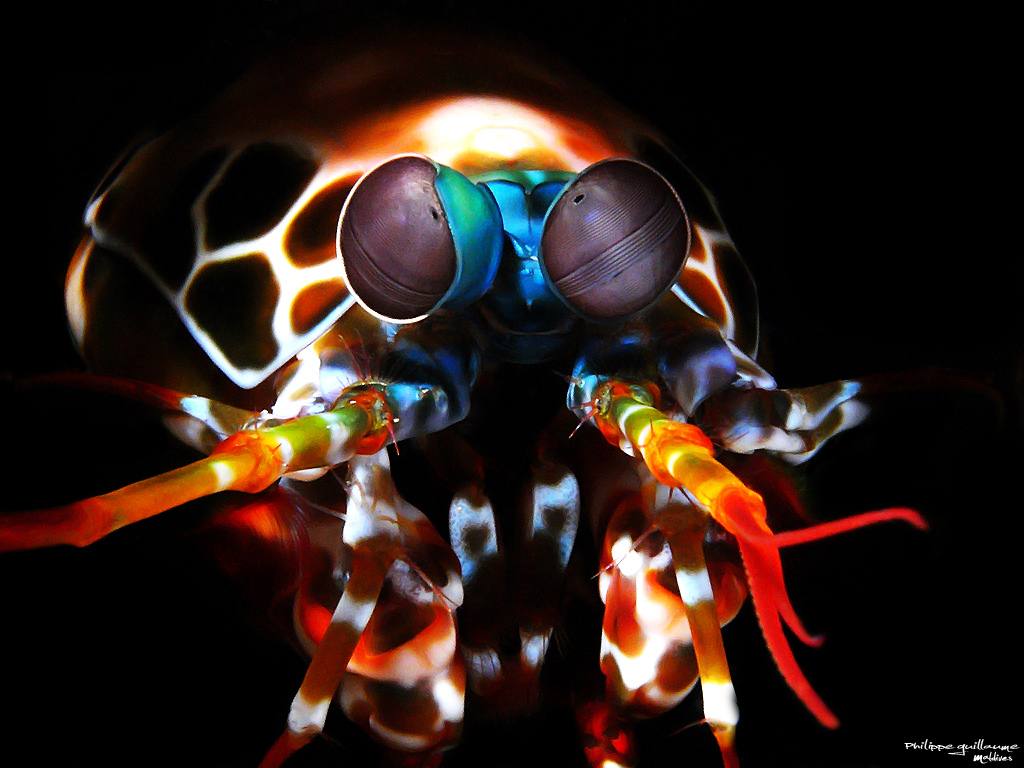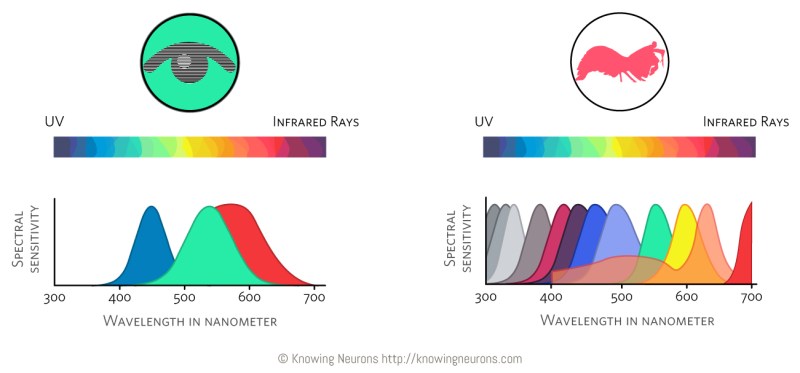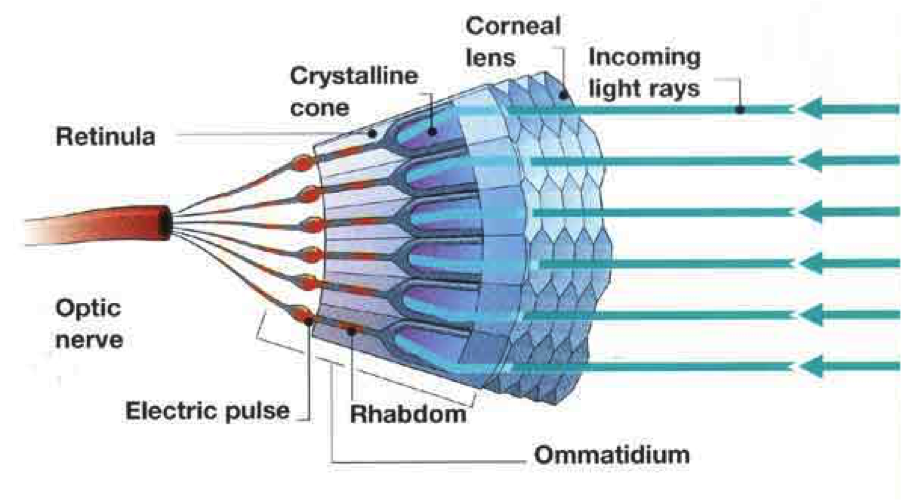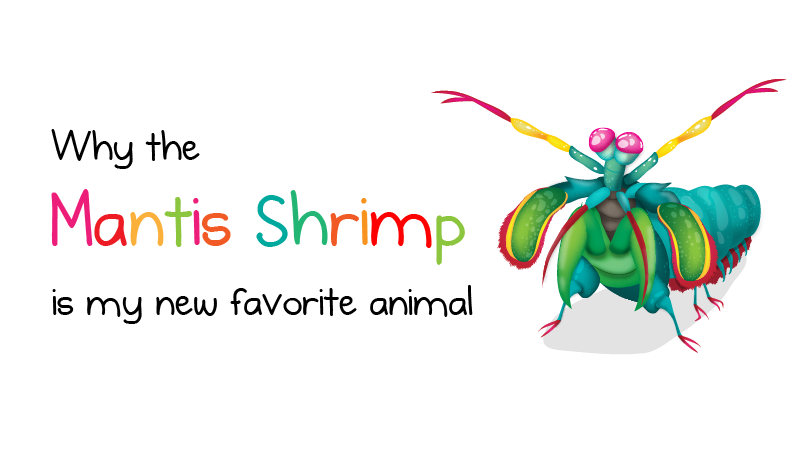
Color vision is a complex and interesting subject to learn more about because of how significant it is in our understanding and perception of the world and how diverse color vision is in our world. I find it fascinating to think about the varieties of colors we see and how they make up our world; for example, we perceive the sky is blue, trees as green, and the spectrum of visible colors that make up a rainbow. Living in a world of such diverse colors sparked my curiosity about human perception of color vision and how it compares to the way in which other species may view the same scenes and environments we do.
While taking Arts on the Brain, we were introduced to a fascinating animal known as the mantis shrimp. I had heard about this organism before and even managed to work with one at a summer program years ago, so I was pleasantly surprised to be discussing, and now investigating, the mantis shrimp even further. The mantis shrimp boasts several intriguing adaptations, some of which include the ability to spear or smash their prey with literal bullet speed and the evolution of 12 different types of photoreceptors in their eyes. This evolutionary trait poses interesting questions related to how useful such a characteristic is and how the mantis shrimp sees the world. Some of those questions include how does mantis shrimp vision compare to ours, why do the mantis shrimp have so many different photoreceptors, and what is the mechanism of their vision?

Human color vision is determined by three different types of photoreceptors, making our vision trichromatic. These three types are “green”, “blue”, and “red” receptors, which, as mentioned before, gives us vision of the visible spectrum of light. Humans also have an incredibly precise and accurate ability to distinguish and identify between colors. Remarkably, despite having about 4 times as many photoreceptors as humans, mantis shrimp are actually rather poor at discriminating between colors. According to Fehlhaber, this may be because the cones in human eyes have intricate mechanisms which allow them to work together to detect differences in color based on the differences of the cone responses as well as a network of neural computations to process that sensory information.
In contrast, cones in mantis shrimp eyes “work independently of each other, without complicated neural computations” (Fehlhaber, 2016). This is further elaborated on by Cronin & Marshall who write that when sensory data leaves the retina and begins processing in the central nervous system in mantis shrimp, there are “numerous parallel data streams” that allow the processing of several pieces of data simultaneously. This type of vision may not allow for accurate processing of distinct colors, however it does let them quickly identify the presence of a color which may prove to be advantageous in quickly identifying predators or prey.

Mantis shrimp only use three photoreceptors for actual color vision, which leaves the function of the nine other photoreceptor modalities in question. If the mantis shrimp can see color with only three photoreceptors, why do they spend the resources and energy to develop twelve photoreceptors instead? The other receptors are likely used to receive visual data from ultraviolet light and polarized light (Cronin & Marshall, 2001).

Like most animals, mantis shrimp require a form of gaze stabilization. Gaze stabilization is the phenomenon when an organism’s eyes correct for errors made in visual processing by accounting for existential factors, such as blur, so that the organism can have a clear view of the world (Daly, How, Partridge, Temple, Marshall, Cronin, & Roberts, 2016). In fact, different animals have various strategies to stabilize their gaze including “using eye, head, and body movements to avoid motion blur” (Daly et al., 2016). The most prominent forms of gaze stabilization in mantis shrimp incorporate three types of eye rotation known as “pitch, yaw, and torsional(roll)” (Daly et al., 2016). These three rotations form an intricate gaze stabilization system that has a large range of scanning eye movements, allowing the mantis shrimp to be very discerning and analytical of any movements in their vision. Using this scanning technique coupled with the 12 photoreceptor modalities, mantis shrimp vision allows for “rapid color recognition without the need to discriminate between wavelengths within a spectrum.” (Thoen, How, Chiou, & Marshall, 2014). This unique technique gives mantis shrimp an evolutionary advantage as a predator, to quickly attack prey without them being aware, and as a prey, to notice signs of danger and make a rapid escape.

The mantis shrimp eye has one of, if not the most unique and fascinating visual systems in all of the animal kingdom. In fact, it is such a perplexing phenomenon of nature that scientists and researchers are looking into improving existing machine vision and create an entirely new pair of glasses that allow you to see from a mantis shrimp’s perspective (https://www.theatlantic.com/science/archive/2018/04/mantis-shrimp-eye-camera/557195/).
Learning more about the several strange and intriguing components of their vision only raises more questions within me. The scientific curiosity I felt all those years ago when I first encountered the mantis shrimp in my summer program has been rekindled and I look forward to doing more research to answer some of these more pressing questions.
The mantis shrimp is awesome.
The mantis shrimp is indeed very fascinating! It’s quite intriguing to see how many smaller creatures tend to have extremely sophisticated sensory systems and mechanisms. It will be interesting to see how far we can go in developing technology to allow humans to visualise their surroundings in as well-defined a manner as the mantis shrimp. I also wonder whether there are any disadvantages that could arise with being able to see wavelengths beyond a certain frequency and whether certain mutations could eventually result in natural selection favouring a species with a completely different visual sensory system.
Hi Jorge! I really enjoyed reading your blog. I thought it was really cool how you were able to connect the topic of the color vision of the mantis shrimp that you learned about in a summer program in the past to something you learned in Arts on the Brain! It was very interesting to learn about how the mantis shrimp has so many more photoreceptors than humans, yet they only use three for color vision just like humans! Your writing was very detailed and easy to follow, and I could really see the passion for the topic seep through your writing. Great job!
Thank you for such an in-depth and informative website! It helped me very much and I now know many things that I didn’t know before! Something that caught my attention was the diagram of the Mantis Shrimp’s eye. It would be really helpful if it showed how the parts of the eye worked together and formed such amazing eyesight! If you see this comment, would you mind explaining to me how the different parts of their eyes work?
Thank you!
This was a super great write-up for me to read right after my class! I literally just learned about the mantis shrimp and our vision in my Arts on the Brain class (Current Freshman) so reading this to gain a better understanding of it is super interesting! This was an extremely in-depth follow up to what I just learned, I love the passion in this post 🙂